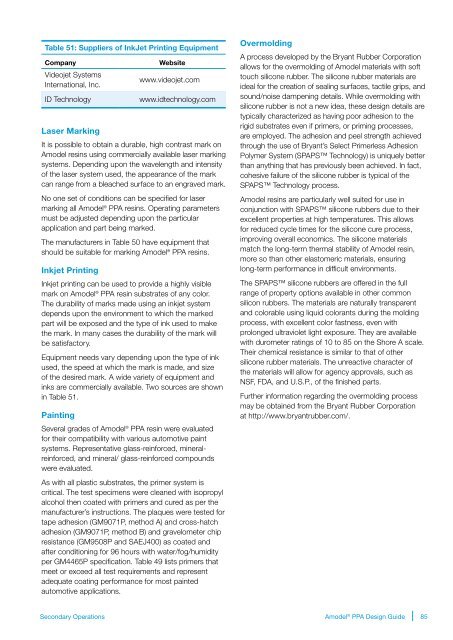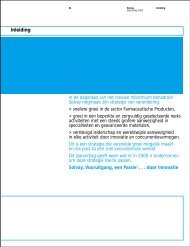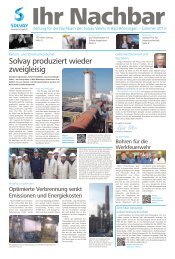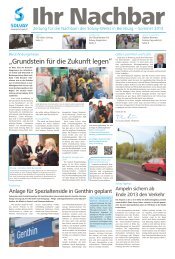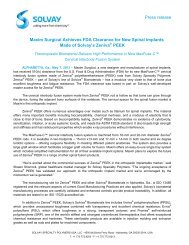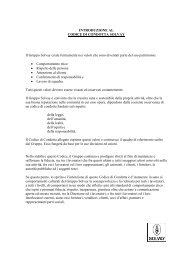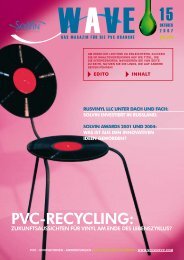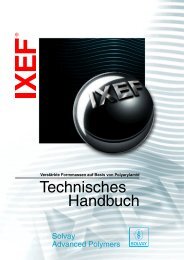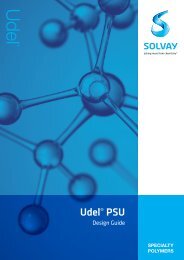Design Guide - Solvay Plastics
Design Guide - Solvay Plastics
Design Guide - Solvay Plastics
Create successful ePaper yourself
Turn your PDF publications into a flip-book with our unique Google optimized e-Paper software.
Table 51: Suppliers of InkJet Printing Equipment<br />
Company<br />
Videojet Systems<br />
International, Inc.<br />
ID Technology<br />
Laser Marking<br />
Website<br />
www.videojet.com<br />
www.idtechnology.com<br />
It is possible to obtain a durable, high contrast mark on<br />
Amodel resins using commercially available laser marking<br />
systems. Depending upon the wavelength and intensity<br />
of the laser system used, the appearance of the mark<br />
can range from a bleached surface to an engraved mark.<br />
No one set of conditions can be specified for laser<br />
marking all Amodel ® PPA resins. Operating parameters<br />
must be adjusted depending upon the particular<br />
application and part being marked.<br />
The manufacturers in Table 50 have equipment that<br />
should be suitable for marking Amodel ® PPA resins.<br />
Inkjet Printing<br />
Inkjet printing can be used to provide a highly visible<br />
mark on Amodel ® PPA resin substrates of any color.<br />
The durability of marks made using an inkjet system<br />
depends upon the environment to which the marked<br />
part will be exposed and the type of ink used to make<br />
the mark. In many cases the durability of the mark will<br />
be satisfactory.<br />
Equipment needs vary depending upon the type of ink<br />
used, the speed at which the mark is made, and size<br />
of the desired mark. A wide variety of equipment and<br />
inks are commercially available. Two sources are shown<br />
in Table 51.<br />
Painting<br />
Several grades of Amodel ® PPA resin were evaluated<br />
for their compatibility with various automotive paint<br />
systems. Representative glass-reinforced, mineralreinforced,<br />
and mineral/ glass-reinforced compounds<br />
were evaluated.<br />
As with all plastic substrates, the primer system is<br />
critical. The test specimens were cleaned with isopropyl<br />
alcohol then coated with primers and cured as per the<br />
manufacturer’s instructions. The plaques were tested for<br />
tape adhesion (GM9071P, method A) and cross-hatch<br />
adhesion (GM9071P, method B) and gravelometer chip<br />
resistance (GM9508P and SAEJ400) as coated and<br />
after conditioning for 96 hours with water/fog/humidity<br />
per GM4465P specification. Table 49 lists primers that<br />
meet or exceed all test requirements and represent<br />
adequate coating performance for most painted<br />
automotive applications.<br />
Overmolding<br />
A process developed by the Bryant Rubber Corporation<br />
allows for the overmolding of Amodel materials with soft<br />
touch silicone rubber. The silicone rubber materials are<br />
ideal for the creation of sealing surfaces, tactile grips, and<br />
sound/noise dampening details. While overmolding with<br />
silicone rubber is not a new idea, these design details are<br />
typically characterized as having poor adhesion to the<br />
rigid substrates even if primers, or priming processes,<br />
are employed. The adhesion and peel strength achieved<br />
through the use of Bryant’s Select Primerless Adhesion<br />
Polymer System (SPAPS Technology) is uniquely better<br />
than anything that has previously been achieved. In fact,<br />
cohesive failure of the silicone rubber is typical of the<br />
SPAPS Technology process.<br />
Amodel resins are particularly well suited for use in<br />
conjunction with SPAPS silicone rubbers due to their<br />
excellent properties at high temperatures. This allows<br />
for reduced cycle times for the silicone cure process,<br />
improving overall economics. The silicone materials<br />
match the long-term thermal stability of Amodel resin,<br />
more so than other elastomeric materials, ensuring<br />
long-term performance in difficult environments.<br />
The SPAPS silicone rubbers are offered in the full<br />
range of property options available in other common<br />
silicon rubbers. The materials are naturally transparent<br />
and colorable using liquid colorants during the molding<br />
process, with excellent color fastness, even with<br />
prolonged ultraviolet light exposure. They are available<br />
with durometer ratings of 10 to 85 on the Shore A scale.<br />
Their chemical resistance is similar to that of other<br />
silicone rubber materials. The unreactive character of<br />
the materials will allow for agency approvals, such as<br />
NSF, FDA, and U.S.P., of the finished parts.<br />
Further information regarding the overmolding process<br />
may be obtained from the Bryant Rubber Corporation<br />
at http://www.bryantrubber.com/.<br />
Secondary Operations<br />
Amodel ® PPA <strong>Design</strong> <strong>Guide</strong><br />
85


